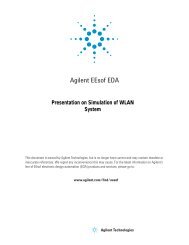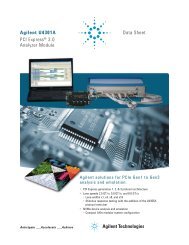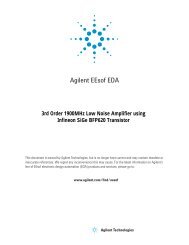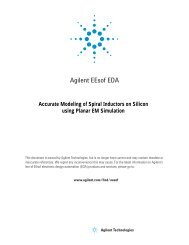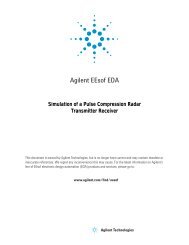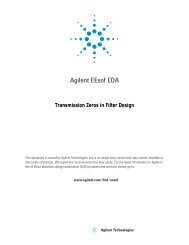Agilent 34980A Multifunction Switch/Measure Unit *34980-90005*
Agilent 34980A Multifunction Switch/Measure Unit *34980-90005*
Agilent 34980A Multifunction Switch/Measure Unit *34980-90005*
Create successful ePaper yourself
Turn your PDF publications into a flip-book with our unique Google optimized e-Paper software.
Features and Functions 3<br />
You must configure the channel (function, transducer type, etc.) before<br />
setting any alarm limits. If you change the measurement configuration,<br />
alarms are turned off and the limit values are cleared. Alarms are also<br />
turned off when you change the temperature probe type, temperature<br />
units, or disable the internal DMM.<br />
If you plan to use alarms on a channel which will also use Mx+B<br />
scaling, be sure to configure the scaling values first. If you attempt to<br />
assign the alarm limits first, the instrument will turn off alarms and<br />
clear the limit values when you enable scaling on that channel. If you<br />
specify a custom measurement label with scaling, it is automatically<br />
used when alarms are logged on that channel.<br />
If you redefine the scan list, alarms are no longer evaluated on those<br />
channels (during a scan) but the limit values are not cleared. If you<br />
decide to add a channel back to the scan list (without changing the<br />
function), the original limit values are restored and alarms are turned<br />
back on. This makes it easy to temporarily remove a channel from the<br />
scan list without entering the alarm values again.<br />
Each time you start a new scan, the instrument clears all readings<br />
(including alarm data) stored in reading memory from the previous<br />
scan. Therefore, the contents of reading memory are always from the<br />
most recent scan.<br />
As shown below, alarms are logged in the alarm queue only when a<br />
reading crosses a limit, not while it remains outside the limit and not<br />
when it returns to within limits.<br />
Alarm Event No Alarm<br />
Upper Limit<br />
Lower Limit<br />
Four TTL alarm outputs are available on the rear- panel Alarms<br />
connector. You can use these hardware outputs to trigger external alarm<br />
lights, sirens, or send a TTL pulse to your control system. <br />
You can also initiate a scan sweep (no external wiring required) when<br />
an alarm event is logged on a channel. For complete details, refer to<br />
“Using the Alarm Output Lines” on page 136.<br />
<strong>Agilent</strong> <strong>34980A</strong> Mainframe User’s Guide 133





